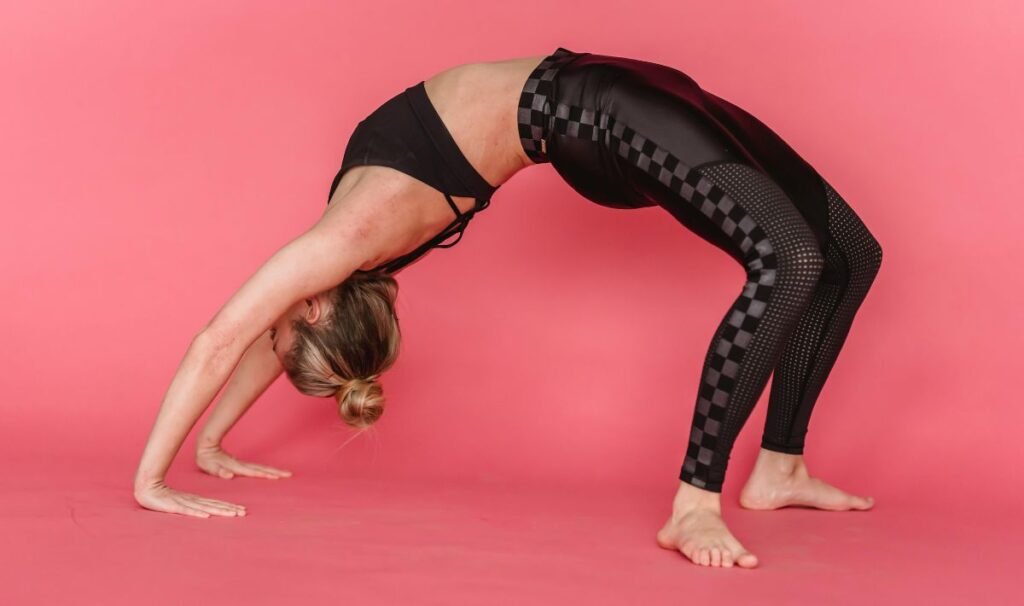In yoga, every pose has a purpose, and Simhasana, or Lion’s Pose, is a powerful one. Known for its unique look and invigorating breathing, Lion Pose combines a seated posture with a fierce, lion-like exhale to relieve tension, release anger, and rejuvenate the body and mind. This article explores everything you need to know about Lion’s Pose, also called Lion Breathing Yoga, from how to do it correctly to its surprising benefits. Whether you’re looking to improve your mental clarity or tone your face and throat, Simhasana has something to offer.
What is Lion’s Pose (Simhasana)?
Lion’s Pose, known in Sanskrit as Simhasana (simha means lion), is a powerful seated posture in yoga that’s both energizing and therapeutic. This pose is often recognized for its exaggerated “roaring” breath and facial expressions, designed to mimic a lion’s ferocity. Unlike many other yoga postures, Lion Pose focuses intensely on breath control and facial muscles, offering a unique combination of physical, mental, and emotional benefits. The main objective of Simhasana is to release tension throughout the face, throat, and chest while promoting a sense of inner strength and vitality.
Why Practice Lion Pose?
Simhasana is believed to unblock suppressed emotions and improve self-expression, making it a powerful addition to your yoga practice. Often recommended for people experiencing stress, anger, or pent-up frustration, Lion Pose offers a natural way to let go of these feelings through the symbolic roar and intense breathwork.
How to Do Lion’s Pose: Step-by-Step Guide
Practicing Lion Pose doesn’t require you to be flexible or have years of yoga experience, but mastering the proper technique can make a difference in experiencing its full benefits. Follow these steps to perform Simhasana correctly:
Step 1: Begin in a Comfortable Seated Position
- Start by sitting on your yoga mat in a kneeling position (known as Vajrasana or Thunderbolt Pose).
- Position your knees slightly apart and rest your hands on your thighs.
- Alternatively, sit in a cross-legged position if kneeling is uncomfortable.
Step 2: Position Your Hands and Lean Forward
- Place your hands firmly on your knees with your fingers spread wide.
- Lean forward slightly, keeping your back straight and your gaze forward.
Step 3: Engage Your Face and Throat Muscles
- Open your mouth wide and stick out your tongue as far as possible.
- Imagine you are about to “roar” like a lion, and feel the stretch in your jaw, tongue, and throat.
- Gaze between your eyebrows or at the tip of your nose.
Step 4: Perform the “Lion’s Breath”
- Take a deep inhale through your nose.
- Exhale forcefully through your mouth with a “ha” sound, pushing the air out of your lungs.
- As you exhale, engage the muscles of your throat and diaphragm.
- Repeat this breathing cycle three to five times.
Step 5: Return to a Neutral Position
- Release the pose by relaxing your face and throat.
- Sit quietly for a few breaths, observing any sensations or feelings that arise.
Readmore: 5 Yoga Poses to Counteract Sitting at a Desk All Day
Readmore: The Origins of Yoga: History, Evolution & Future Trends
The Benefits of Lion’s Pose
Simhasana offers a variety of mental, physical, and emotional benefits, making it more than just an interesting posture. Here are some of the key benefits of practicing Lion’s Pose regularly:
1 . Relieves Stress and Tension
One of the most immediate effects of Lion Pose is the release of tension in the face, neck, and upper chest. The exaggerated facial expression and forceful exhale help to release built-up stress, making it easier to relax both physically and mentally.
2. Boosts Confidence and Self-Expression
Since Lion Pose requires such an expressive facial posture, it encourages the release of self-consciousness. Practicing this pose regularly can improve self-confidence and enhance communication skills by helping you become more comfortable expressing yourself.
3. Promotes Circulation to the Face and Throat
The stretch and stimulation of the muscles around the face, neck, and throat increase blood flow to these areas, which may have cosmetic benefits, such as reducing signs of aging, puffiness, and dullness around the face and eyes.
4. Supports Respiratory Health
Lion’s Pose is a great way to strengthen the respiratory muscles, particularly the diaphragm and intercostal muscles. This can improve breathing efficiency, helping with respiratory issues like asthma and shortness of breath.
5. Aids in Relieving Sore Throat and Bad Breath
The strong exhalation and stretching of the throat muscles help clear out stale air and reduce any microbial buildup in the mouth and throat. Practitioners often find relief from common throat discomforts and bad breath.
6. Improves Focus and Reduces Mental Fatigue
Simhasana requires mental concentration, especially when coordinating the breath with the facial expressions. This focus helps to clear mental clutter and improve cognitive clarity, making it easier to manage mental fatigue and stress.
Precautions and Contraindications for Lion’s Pose
Though Lion Pose is generally safe for most people, there are a few precautions to consider:
- Throat Sensitivity: If you have a sore throat or any throat injury, practice Simhasana gently, or skip it until you’re feeling better.
- Facial Muscle Issues: People with TMJ (temporomandibular joint) problems should be cautious, as opening the mouth wide can strain the jaw muscles.
- Respiratory Conditions: Those with asthma or other respiratory issues may find the breathwork challenging, so it’s best to go slowly and avoid overexerting the exhale.
Tips for Practicing Simhasana Safely
- Warm-Up: Loosen your neck, jaw, and shoulders with gentle stretches before starting.
- Start Slowly: If Lion’s Pose feels intense, try a modified version with a less forceful exhale or a gentler facial stretch.
- Practice in a Private Space: Many beginners find Lion Pose challenging to perform in public due to its unique expressions, so try practicing in a comfortable, private space.
- Breathe Naturally: After completing the intense breaths, allow yourself to take a few regular breaths to avoid dizziness.
Readmore: Winter Wellness: 12 Yoga Poses to Stay Warm
Readmore: Evening Yoga Poses to Unwind After a Long Day
Incorporating Lion Pose into Your Routine
Lion Pose can be practiced on its own or as part of a larger yoga sequence. It’s particularly beneficial when done at the end of a yoga session, as it helps release any residual tension. Consider the following tips to incorporate Lion Pose effectively:
- During Morning Practice: Lion Pose can stimulate energy and boost mood, making it ideal for morning yoga sequences.
- Paired with Breathwork: Combine Lion’s Breath with Pranayama (yogic breathing) exercises for a fuller respiratory workout.
- Before Meditation: Lion Pose helps to clear mental distractions, so practicing it before meditation can enhance focus and calmness.
Conclusion
Lion’s Pose, or Simhasana, is a uniquely powerful yoga posture that engages both the body and mind. By practicing Lion Pose regularly, you can experience numerous benefits, including reduced stress, improved self-confidence, enhanced respiratory health, and even anti-aging effects. Whether you’re a yoga beginner or a seasoned practitioner, Simhasana is a valuable addition to any yoga routine, helping you tap into a fierce sense of self-expression and mental clarity.
Incorporate this pose into your daily routine to reap its full benefits and feel the strength of the lion within.
Readmore: Sleeping Swan Yoga Pose
Readmore: How to Perfect Runner’s Lunge Yoga Pose
FAQs
What is Lion’s Pose in yoga, and why is it called that?
Lion’s Pose, or Simhasana, is a seated yoga posture where you open your mouth wide, stick out your tongue, and exhale forcefully to mimic the fierce look of a lion. This pose combines breathwork and facial expressions to help release tension, and stress and enhance self-expression.
How do I perform Lion’s Pose (Simhasana) correctly?
To perform Lion’s Pose:
Sit comfortably in a kneeling or cross-legged position.
Place your hands on your knees, lean forward slightly, and spread your fingers wide.
Open your mouth wide, stick out your tongue, and gaze between your eyebrows.
Inhale deeply and exhale forcefully with a “ha” sound, pushing the breath out of your lungs. Repeat 3-5 times.
What are the main benefits of Lion’s Pose?
Lion’s Pose offers many benefits, including:
Stress and tension relief, especially in the face and throat.
Increased self-confidence and improved self-expression.
Better circulation in the face, reducing signs of aging.
Respiratory health support through strengthened breathing muscles.
Relief from sore throat and bad breath.
How often should I practice Lion’s Pose to see results?
Practicing Lion’s Pose 2-3 times a week can help reduce stress and improve circulation. For greater respiratory benefits or tension relief, you can practice it daily. Just a few minutes can make a noticeable difference.
Can beginners practice Lion’s Pose?
Yes! Lion’s Pose is suitable for beginners and doesn’t require advanced flexibility or strength. However, beginners should start gently, especially with the forceful exhalation, and work up to a more intense “roar” over time.

Sonu is a passionate yoga teacher with over 6+ years of experience helping individuals find balance, strength, and inner peace through the transformative power of yoga. As the creator of Pure Yoga Vibes, Sonu shares expert insights, inspiring practices, and a wealth of knowledge to support your wellness journey. Dedicated to creating a space for growth and mindfulness, Sonu’s mission is to make yoga accessible and enjoyable for everyone. For inquiries or collaborations, feel free to reach out at contact@pureyogavibes.com.


